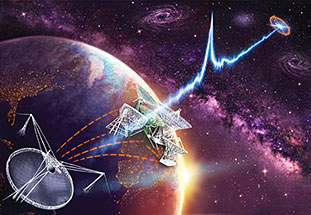A fast radio burst’s extragalactic home
DOI: 10.1063/PT.3.3487
Discovered in 2007, fast radio bursts (FRBs) emit luminous pulses of radio light that last mere milliseconds. To date, astronomers have reported about 20 FRBs but don’t know what causes them. One, identified in 2014 by Laura Spitler and colleagues, stands apart because it has been observed to burst repeatedly (see Physics Today, April 2016, page 22

DANIELLE FUTSELAAR

The researchers also observed the neighborhood of FRB121102 with the Gemini North optical telescope. They determined that the location of the FRB coincides with that of a dwarf galaxy some 3 billion light-years distant from Earth. Although astronomers had expected FRBs to lie beyond the Milky Way, some models allowed for sources in our galaxy; the new work provides the first direct confirmation of the earlier consensus. Dwarf galaxies are more likely than regular galaxies to host two other classes of high-energy transients: superluminous supernovae and long-duration gamma-ray bursts. The observation of an FRB in a dwarf galaxy creates the tantalizing prospect that all three types of high-energy events may be generated by massive progenitors. (S. Chatterjee et al., Nature 541, 58, 2017, doi:10.1038/nature20797
